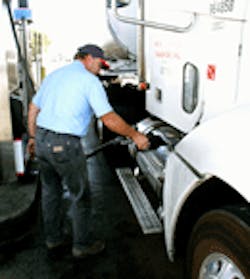As part of the Obama administration’s effort to reduce carbon dioxide (CO2) emissions from vehicles to address climate change concerns, the Federal government is proposing new greenhouse gas (GHG)/fuel economy standards for commercial trucks and buses to take effect in 2014 and 2018.
Crafted jointly by the Environmental Protection Agency (EPA) and the National Highway Traffic Safety Administration (NHTSA), the new GHG/fuel economy proposals are “tiered” to cover three distinct vehicle categories, according to those agencies: heavy trucks and tractor-trailers, heavy-duty pickups and vans, and vocational vehicles.
- For tractor-trailers, the proposed engine and vehicle standards begin in the 2014 model year and establish a 20% reduction in CO2 emissions and fuel consumption by the 2018 model year.
- For heavy-duty pickup trucks and vans, the agencies are proposing separate gasoline and diesel truck standards which phase in starting in the 2014 model year and achieve up to a 10% reduction for gasoline vehicles and 15% reduction for diesel vehicles by the 2018 model year (12% and 17% respectively if accounting for air conditioning leakage).
- Lastly, for vocational vehicles, the agencies are proposing engine and vehicle standards starting in the 2014 model year which would achieve up to a 10% reduction in fuel consumption and CO2 emissions by the 2018 model year.
The EPA and NHTSA (a division of the U.S. Dept. of Transportation) jointly estimate that the new rules would provide $41 billion in net benefits over the lifetime of model year 2014 to 2018 vehicles. With the potential for significant fuel efficiency gains ranging from 7% to 20%, they calculate the rules could save up to $74,000 over a heavy truck’s useful life with only an additional upfront investment of $5,900 per unit.
In terms of pollution control, the EPA figures the new rules would reduce GHG emissions by nearly 250 million metric tons, cut carbon monoxide emissions by 11,000 million metric tons, eliminate 33,000 million metric tons of oxides of nitrogen (NOx), and remove 12,000 million metric tons of particulate matter (PM).
“We’ve said all along that such regulations offer a transition to lower pollution and less energy use by the transportation sector,” said Lisa Jackson, EPA’s administrator, in a conference call with reporters. “What makes such regulations so successful is that they are performance standards that [establish] a roadmap many years out to provide flexibility so [vehicle] manufacturers can meet them in the most cost effective way.”
The key, she said, is that these are not “one size fits all” standards, which is why GHG per ton mile and fuel consumed per ton mile metrics are used. That approach will allow industry to use any combination of technologies to meet the new standards, while allowing flexibility to address the many differences in operational patterns encountered among truck operators, Jackson added.
Each vehicle category will also use different fuel-efficiency measurements intended to accommodate the wide range of operating conditions faced by commercial truck users.
EPA officials also noted that they plan to use industry-established computer models to measure the fuel efficiency of aerodynamic, tire and engine performance, as well as other truck components. Both agencies added that a 60-day comment now begins for these proposals, which can accessed at either http://www.epa.gov/otaq/climate/regulations.htm or http://www.nhtsa.gov/fuel-economy.
“Through new fuel-efficiency standards for trucks and buses, we will not only reduce transportation’s environmental impact, we’ll reduce the cost of transporting freight,” said Ray LaHood, U.S. Transportation Secretary. “This is a win-win-win for the environment, businesses and the American consumer.”
About the Author
Sean Kilcarr
Editor in Chief
Sean Kilcarr is a former longtime FleetOwner senior editor who wrote for the publication from 2000 to 2018. He served as editor-in-chief from 2017 to 2018.
